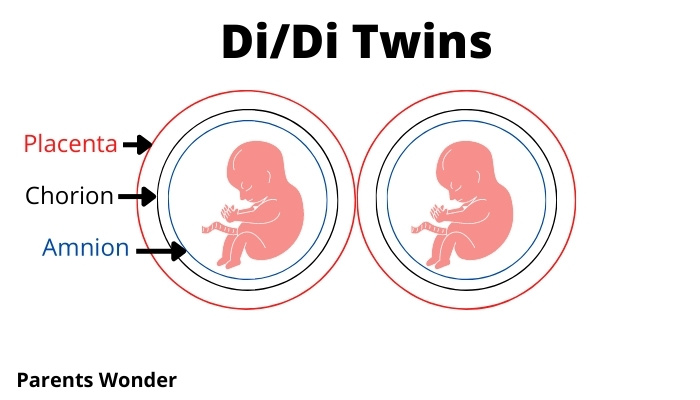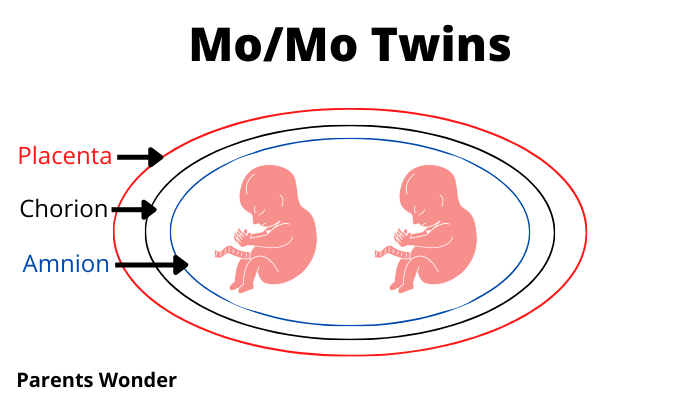Great news! You have just discovered that you are going to have twins!
You probably went straight to the internet and started learning all you can about twins, am I right? It is likely that you found lingo very specific to twin pregnancies.
You have probably seen or heard the abbreviations mo/di, mo/mo, and di/di in your research about twin pregnancies. Mo/di twins? What does that mean? If the doctor told you that it looks like you are expecting mo/di twins, read on.
What are mo/di twins? Monochorionic diamniotic (mo/di) twins are identical twins that each have their own amniotic sac but share the same chorionic sac and the same placenta. The way in which the egg splits and the timing thereof determines whether identical twins will be mo/di, di/di, or mo/mo.
In this article, we will cover exactly what this looks like and give more specific information about what to expect with monochorionic diamniotic twins!
Monochorionic Diamniotic Twins
Mo/di twins are one type of identical twin pregnancy. To understand what monochorionic diamniotic means, there is some specific vocabulary and anatomy to know. Let’s break it down a little.
How Twins Develop – The Basics
An identical twin pregnancy starts just like any other pregnancy- with one egg and one sperm.
However, after fertilization, the egg divides and creates two identically genetic embryos instead of remaining one large clump of cells as it does in a singleton pregnancy.
A fraternal twin pregnancy is different from the beginning. It begins with two eggs and two sperm rather than just one.
Essentially, the babies are normal siblings who just happen to be developing at the same time. They are not genetically identical.
Understanding Mo/Di Twins
So, what does it mean if you have mo/di twins? It means that your twins share a chorion, but each baby has their own amnions.
Um, what?
In every healthy pregnancy, an amnion and chorion are present within the placenta. They are embryonic membranes that play a vital role in the nourishment and protection of the embryo while in development.
The amnion is the thin, but very tough, sac of membranes that covers an embryo. Commonly known as the amniotic sac, its main purpose is to protect the embryo in the womb and reduce the risk of injury or harm to the fetus during pregnancy.
The amnion is expandable and flexible to accommodate the growing baby. It is filled with a liquid known as amniotic fluid that absorbs any shock from the outside environment in order to protect the baby.
The chorion is a membrane around the amnion that provides extra protection but also promotes the exchange of nutrients and necessary fluids between the mother and the embryo.
A mother’s blood is the main source of nourishment for a growing baby as it carries all of the nutrients vital for growth and development.
Identical twins form when one egg divides into two after it has been fertilized; we know that. However, when that division takes place determines if the twins will be mo/mo or mo/di.
Mo/di twins form when the egg splits 4-8 days after fertilization and after the placenta has already formed.
Therefore, mo/di twins share a chorion and a placenta but are each in their own amniotic sac.
Think of it this way: Mo/di twins are like two rooms in a house. They are each divided by their own interior walls; however, they share the same exterior structure.
*See the illustration below for a visual aid.
Mo/Di Twins Sex
Mo/di twins are always the same sex. This is because they form from the same egg and thus are always identical in nature.
Are Mo/Di Twins High Risk?
All twin pregnancies carry more risk than singleton pregnancies and are monitored very closely. Mo/di twins are a bit more “high risk” because there is only one placenta and two babies who need the nutrients.
When a placenta is shared between two embryos, there is a risk for complications related to a shared blood supply and an imbalance in nutrient distribution.
Mo/Di Twin Risks
Once doctors have identified a pregnancy as monochorionic, they begin doing tests for any complications due to the sharing of the placenta.
One-third of all monochorionic pregnancies experience an unequal sharing of blood supply, nutrients, and blood volume.
More severe complications include twin-to-twin transfusion syndrome (TTTS) or twin anemia polycythemia sequence (TAPS), which occur when blood volume or oxygen are unequally distributed between the two twins.
Selective intrauterine growth restriction (sIUGR) can occur when there is an unequal distribution of nutrients through the placenta and one twin becomes malnourished.
Monochorionic Diamniotic Survival Rate
89% of all mo/di twins detected in the first trimester survive in utero.
Are All Mo/Di Twins Identical?
Yes. Because mo/di twins develop from one original egg, they will always share DNA that is very close to being 100% identical.
How Do You Know if Your Twins Are Mo/Di?
Ultrasound technology can show if your twins are nestled in two amniotic sacs and can also show if there are one or two placentas.
However, sometimes the placentas fuse together making it look like one placenta. Therefore, a DNA test is the most accurate way to tell if you truly have mo/di twins.
Mo/Di Twin Delivery
Doctors recommend delivery of mo/di twins between 34-37 weeks gestation. Whether it is a vaginal or cesarean delivery will depend upon the position of the twins as well as the doctor’s level of experience.
Types of Twin Pregnancies
Most people believe there are only two types of twin pregnancies: identical or fraternal. However, there is much more to it than that!
Di/Di Twins

Dichorionic diamniotic twins are identical or fraternal twins who have two chorions, two placentas, and two amniotic sacs. They may be different genders if they are dizygotic (fraternal).
Mo/Di Twins

Mo/di twins are identical twins who share a chorion and placenta but are in two amniotic sacs.
Mo/Mo Twins

Monochorionic monoamniotic twins develop within one chorion and one amniotic sac with one placenta.
Monozygotic vs. Dizygotic
Monozygotic means that one egg split into two embryos after fertilization, yielding identical twins.
Dizygotic means that a woman dropped two eggs during ovulation and both were fertilized, yielding fraternal twins.
How Do Fraternal Twins Form?
Fraternal twins form when a woman drops two eggs at the same time and both are fertilized by different sperm. They each form separate embryos, resulting in fraternal twins.
How Do Identical Twins Form?
Identical twins form when a fertilized egg splits into two, resulting in two genetically identical embryos.
Related Questions:
What Are the Odds of Having Mo/Di Twins?
Everyone has a 1/250 chance of having identical twins. As far as we understand today, identical twins occur purely by chance, and they do not run in families as fraternals can.
Can Mo/Di Twins Look Different?
Due to genetic mutations that happen during development, mo/di twins may have slight physical differences, but they will look very similar if not identical in the vast majority of cases.
Final Thoughts
The genetics of identical twin pregnancies can often be confusing! Not to worry, most people will never even know there can be different kinds of identical twins.
Take in what you can, but know that your little ones are special no matter how they are arranged in the womb!
Mom of three (including identical twin boys), wife, and owner of Parents Wonder. This is my place to share my journey as a mother and the helpful insights I learn along the way.

